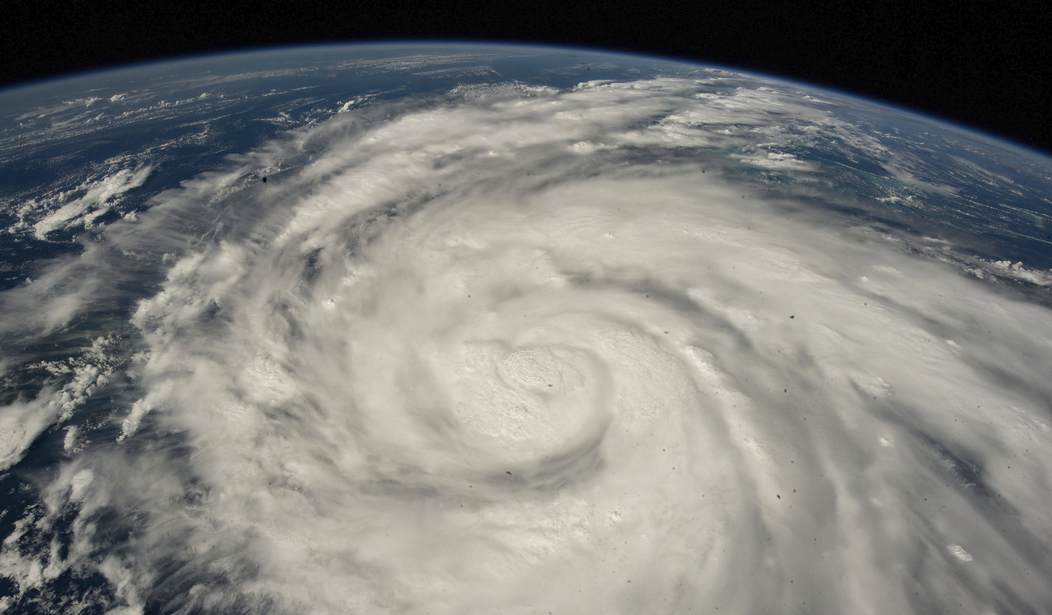The mainstream media continue efforts to convince a credulous public that Hurricane Ian was something unique that resulted from the combined overall effects of human-induced climate change.
The implied assertion is patently untrue.
Weather.com posts a clip showing devastation along one of Florida’s barrier islands near the point of Ian’s landfall. No beach structure remains intact in the photo and there is a small inlet that has been cut into the strand, formerly a continuous beachfront.
The problem with this apparent characterization is that beach erosion and inlet formation often go hand in hand during major coastal storms. This has been the story with any number of past major hurricanes, and even storms that don’t reach hurricane strength, making landfall up and down the US coastline.
Last year, for example, a Nor’easter so eroded beachfront at Winter Haven, complete with forming a new inlet, that county officials were considering buying beachfront homes and tearing them down to return the stretch to its natural state.
Florida’s coast isn’t the only place affected by such storms.
The Outer Banks of North Carolina—and well before the construction of miles and miles of its current million-dollar beach homes, many of them remaining unoccupied for major portions of the year—has been the target of untold numbers of major storms.
In 1846, an unnamed hurricane came ashore along the Outer Banks and its backwash carved out what is now known as Oregon Inlet. The inlet is the main entry route for the in-flooding tides from the Atlantic Ocean into Pamlico Sound. It also accommodates the ebb tides that return the enormous influx back to sea.
Oregon Inlet was so named because the first ship to navigate the new inlet was the USS Oregon that had to ride out the storm back in the sound.
Recommended
But there is more to the story. At various points along North Carolina’s barrier islands (Currituck, Bodie, Pea, Hatteras, Okracoke, Portsmouth Islands, and several other smaller islets, unnamed and sometimes ephemeral), there remain ghost inlets that once channeled the tides twice daily into and out of Currituck, Albemarle, and Pamlico Sounds, but now lie buried as dead inlets choked by wind-driven sand that relentlessly moves up and down the beach onto dunes or forms spits and temporary islets.
Left to their own devices, shoreline processes transport megatons of sand south and southwestward along the arcs of beaches of the Outer Banks and also move the active inlets in the same trending direction, if not prevented aggressively with stabilizing jetties.
But every so often a strong storm will push enough water into the sound that, as its center passes and northeasterly winds abruptly shift to the southwest, a rush of water overwhelms weak spots on the low dunes just inside the active beach and carve out a notch in the sand that may grow into a new inlet. This event is more likely to occur along a stretch where the closest existing inlet is unable to handle the added flow during the storm’s passage.
New inlets are born, and old inlets, no longer able to handle tidal flow become choked with sand and gradually pass into extinction.
In September 2003, Hurricane Isabel struck the south end of Hatteras Island. It cut a new inlet near its southern end that temporarily isolated the community of Hatteras Village from the main island. Heroic-scale efforts by the US Army Corps of Engineers to pump sand finally succeeded in filling in the 2000-foot-wide gap created by the upstart inlet during the ensuing two months, despite vocal opposition by a minority of coastal “experts,” who preferred that natural shore processes be left to their own devices. NC Highway 12 was subsequently reopened to traffic in December 2003.
When I arrived on the scene that same December, two houses were visible half submerged lying hundreds of yards out into Pamlico Sound where the hurricane had deposited them.
The upshot is that, for millennia, long before any human-induced global warming, major tropical storms are fully capable of moving inconceivable quantities of sand in a matter of a few hours during the tidal surge. It should come as no surprise that Ian accomplished the feat at one such Florida location.
William D. Balgord, Ph.D., is President of Environmental & Resources Technology, Inc., Middleton, WI, and a Contributing Writer with The Cornwall Alliance for the Stewardship of Creation<http://www.cornwallal

























Join the conversation as a VIP Member